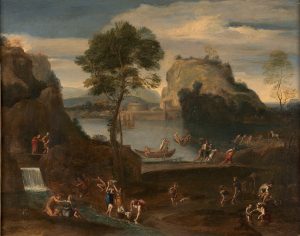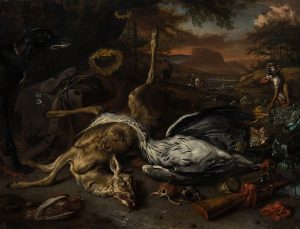Class Notes
Each year, the Ackland teaches thousands of UNC students in hundreds of courses across dozens of disciplines. We developed Class Notes so that you — and all of our visitors — can listen in and participate. Grab a gallery map from the front desk, and let this interactive guide lead the way!
Anthropology, Spring 2024
Click the arrow below to listen to an Ackland lesson plan for a course called “Canine Cultures.”
Click the transcript button below to read the transcript of the audio file.
Hello and welcome to Class Notes. My name is Jo Klevdal and I am the Ackland’s object-based teaching fellow. Each year we teach thousands of students in hundreds of courses across dozens of disciplines. We developed Class Notes so that you — and all of our visitors — can listen in and participate.
Today you’ll be sitting in on an introductory anthropology class called “Canine Cultures.” This class explores the idea that anthropology “makes the strange familiar” and the “familiar strange” by exploring the evolving relationship between dogs and humans. Students are asked to challenge assumptions that they have about dogs — as loyal companions, beloved family members, or personal property — and consider how human attitudes towards canines have developed over the course of history.
We are going to look at two seventeenth-century European works of art to explore different depictions of the human/canine relationship. We will discuss the choices artists have made in depicting dogs and what these choices tell us about human attitudes towards dogs.
We will begin with Landscape with Fishermen, Hunters, and Washerwomen by the Italian painter Domenichino. It’s located in Gallery 15, which you can find on your map. You can also just head straight past the elevator, all the way to the back of the Museum. Keep to your left and you’ll see a dark blue wall. The painting is to the left of the entrance to this gallery.
Now that you’ve found it, take a moment to look at the painting. There’s a lot going on here so get close! Try to notice two to three small details. Once you’ve absorbed some detail, step back and look at the painting from a couple of feet away. Make an inventory of what you see. If you’re with someone, compile a list together. Pause and actually do this.
So, what did you see? Maybe you noticed the groups of people posed in various postures and clothing: men pulling in boats and nets of fish, women washing clothes in the river, men and women gathering firewood, a group of men hunting. Maybe you discussed the dark earth of the foreground and the lighter landscape in the background. Maybe you paid attention to the gleam of the water in the cascade to the left, or the serenity of the lake and the building in the background. Maybe you even saw the horse on the right side of the background and the two dogs in the center and left corner of the foreground.
Domenichino created this painting in 1604, a moment in his career when he was hoping to get more commissions for larger, narrative work. This painting was likely not drawn from a literary source — it simply displays people involved in daily tasks, showing off the artist’s ability to capture motion and action in a variety of figures, both human and canine. Compare and contrast the way Domenichino chose to depict these figures, from brushwork, to color, to detail. What connections can you draw between the humans, the dogs, and the landscape? Pause here and discuss.
A far cry from the animals we cherish as family members today, dogs were not pets in seventeenth-century Italy. Often, they were not even individual property. “Roaming dogs” existed on the periphery of settlements, scavenging discarded scraps and trash, and living alongside, but not necessarily with, humans.
Describe how the dogs fit into the larger scene in this painting. What story does Domenichino tell us about the role of dogs in Italian society? Pause and think about it.
In this piece, dogs are not central figures, or symbols of loyalty, or the property of individuals, but part of a larger, mostly harmonious whole. We are now going to take a look at another, perhaps less harmonious, seventeenth-century painting that speaks to a different aspect of the relationship between dogs and humans.
Turn around and you will see a free-standing, dark blue wall that divides this gallery. Walk around to the other side of this diagonal wall. There is a large painting in the middle, titled Still Life with Hunting Trophies by the Dutch painter Jan Weenix.
Stop for a moment to take it all in. Pay attention to what catches your eye and then how your eyes move around the painting. What choices has the artist made to guide this movement? What aspects of the painting stand out to you and why? Pause and discuss.
Now, I want you to focus on the dogs in this piece. How are they depicted? Pay attention to their posture, their color, expressions. What do you know about them based on these depictions? Pause and discuss their relationship with the rest of the painting.
What did you come up with? Maybe you saw the dogs in the background, in the act of taking down a stag. They are lighter, and painted with less detail, but they are active: running, jumping, and biting. In contrast, the dog in the foreground is quite still. He is also much darker and is wearing a collar. You might have noticed the direction of his gaze or his relaxed yet alert posture.
Still Life with Hunting Trophies depicts the relationship between the hunters and the hunted. Weenix painted this around 1680, a time in which hunting large game, like deer, was restricted to the aristocratic class in Dutch culture. The middle class could not hunt animals like deer, but many could afford large hunting paintings like this one, which they would proudly display in the home. Owning one demonstrated the spending power they had acquired and, perhaps, an aspiration to a certain social class. Considering this, what connection can you make between the multiple depictions of dogs and power? Pause one last time and discuss.
What did you come up with? Maybe you talked about the dog as part of a system of power: related to hunting, as well as an expression of human mastery over nature and social status. Maybe you thought about representations of physical power and violence. Or maybe you thought of something else entirely.
In any case, this brings us to the end of our class today. I encourage you to keep looking around the galleries and see what other dogs you can find. How do their depictions overlap with or diverge from the two paintings we looked at in class today? You can look for other animals, too, and see what they tell you about human culture. Thank you for joining me and I hope to see you again soon!

Domenichino, Italian, 1591-1641, Landscape with Fishermen, Hunters, and Washerwomen, c. 1604, oil on canvas, 25 1/2 x 32 in. (64.8 x 81.3 cm). Ackland Fund, 66.18.1.

Jan Weenix, Dutch, 1642-1719, Still Life with Hunting Trophies, 1680s-1690s?, oil on canvas, 47 15/16 x 62 3/8 in. (121.8 x 158.4 cm). Ackland Fund, 84.43.1.
Image at top of page: Photo by Jon Gardiner/UNC-Chapel Hill
